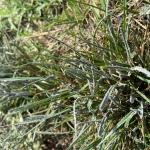Recent wet weather has led to a proliferation of slime molds on lawns and landscape plantings. Slime molds are very unusual looking and appear suddenly, provoking instant curiosity in those who notice them. They come in a striking variety of colors and shapes.
Slime molds are not fungi but belong to the group of single-celled organisms called Protists or Protozoans. These soil-dwelling organisms spend the majority of their lives as single cells, but when conditions are right, these cells begin to aggregate and form visible structures. The purpose of this behavior is reproduction via the generation of spores.
Slime molds are not pathogenic to plants and are highly unlikely to be poisonous to people or pets. Although they are not plant pathogens, they may cause grass to turn yellow because they block sunlight, impeding photosynthesis. They will dry up and disappear after a few days, and the grass will recover. Raking the grass lightly can help speed this process by breaking up the slime mold. Fungicides are ineffective and unnecessary.
The slime mold in the photos is most likely the species Physarum cinereum.
Submitted by: Dr. Angela Madeiras



